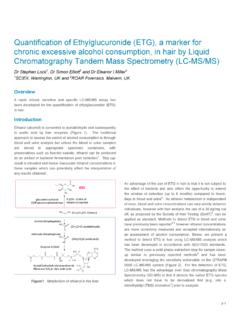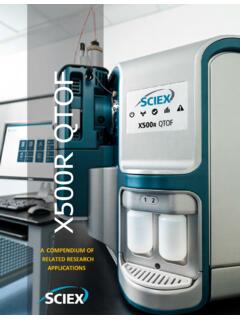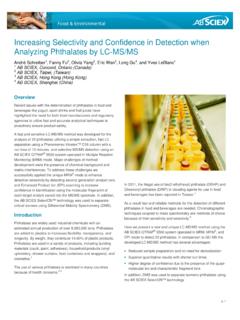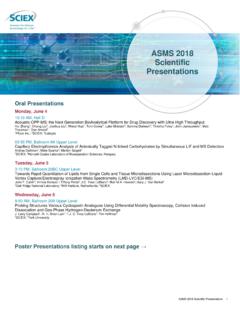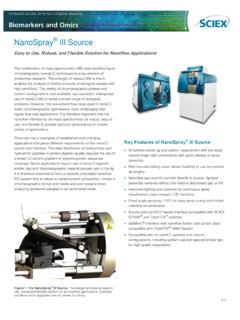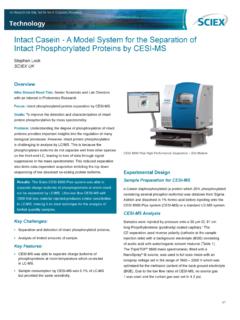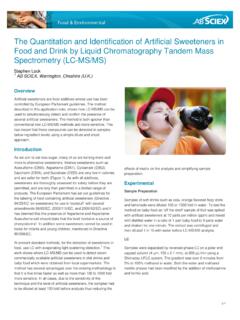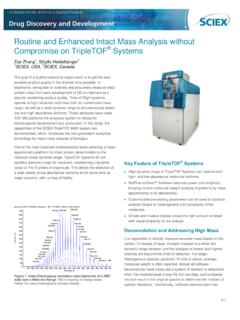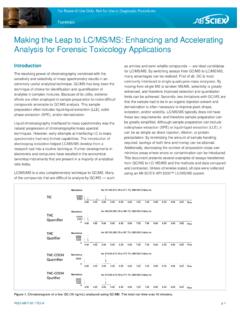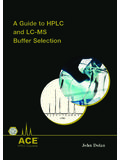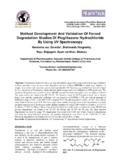Transcription of MRM based Signature Peptide Quantitation …
1 P 1 MRM based Signature Peptide Quantitation Method for follicle stimulating Hormone (FSH) in Human serum SCIEX QTRAP 6500 LC-MS/MS System Faraz Rashid1, Rahul Baghla1, Prashant Kale2, Manoj Shukla 2, Milin Shah2, Dipankar Malakar1, Anoop Kumar1 and Manoj Pillai1 1 SCIEX, 121, Udyog Vihar, Phase IV, Gurgaon, Haryana, India 2 Lambda Therapeutic Research Ltd, SG Highway, Gota, Ahmedabad, India Introduction follicle stimulating hormone (FSH), a kDa gonadotrophic glycoprotein hormone secreted from the anterior pituitary gland plays a key role in regulation of follicular growth in females and spermatogenesis in males1-4. Quantification of FSH holds clinical relevance especially in controlled ovarian stimulation regimens for assisted reproductive technologies and hypogonadotrophic hypogonadism. Traditionally quantification of FSH is done using an ELISA based assay or size exclusion UV based high-performance liquid chromatography.
2 ELISA based commercial kits are available in the market but come with varying linear dynamic ranges and sensitivities. Human FSH is a heterodimer of glycosylated and subunits present in various isoforms that differ in molecular weight, biological potency, half-life of elimination and immunoreactivity. Quantification of FSH in plasma or serum is challenging due to its presence in low abundance, owing to its site specific action. The present work reports the development of sensitive, reproducible Signature Peptide quantification workflow with a wide linear dynamic range in serum using the SCIEX 6500 QTRAP system. Key challenges of FSH Quantitation Poor Sensitivity Achieving a high level of sensitivity is difficult due to its low concentration, the presence of isoforms and its short half-life. Lack of reproducibility and repeatability Low reproducibility and repeatability for FSH at low levels due to high interference in serum.
3 High level of background - Extensive sample preparation is required due to high level of background interference. Unique features of FSH Bioanalytical Quantification in Human Plasma High Selectivity: This bioanalytical method for FSH in plasma achieves better selectivity using a unique Signature Peptide , a simple 1 step sample cleanup and a selective chromatographic method. Accuracy and precision: The accuracy and precision of the Signature Peptide from plasma QC samples was between 95% and 100% nominal and 10-12% CV meeting the validation requirement for regulated bio-analytical labs. Figure 1: Structure of follicle stimulating Hormone (FSH) SCIEX QTRAP 6500 System p 2 Materials and Method Urofollitrophin (FSH) Injection (SITRODIN) 75/150 IU that was used as the reference standard. Chromatographic Conditions: Gradient profile for Signature Peptide identification from FSH protein digests Gradient condition were chosen for maximum resolution of the peptides from digested protein using a Shimadzu Nexera LC system with a Phenomenex Luna RP C18, 100 x mm, m column at 40 C.
4 peptides were chromatographically separated in 35 minutes with an organic gradient of 5-35% acetonitrile ( formic acid) at a flow rate of 300 L/min. Ten microliters of digested FSH was injected. Gradient profile for Signature Peptide Quantitation (MRM) LC System: Shimadzu Nexera with 30AC auto sampler Column: Acquity CSH C18, 100 mm mm, Column Temp: 45 C Injection Volume: 30 L Flow Rate: mL/min Mobile phases: (A) v/v Formic Acid in Water (B) v/v Formic Acid in Acetonitrile Sample Preparation Solid Phase Extraction Various SPE cartridges from different vendors were evaluated to remove the interference from FSH spiked digested matrix during the method development. based on the recovery experiments, Cleanert PCX, 30cc mixed mode strong cation cartridges from Bonna-Agela were used for final method development and validation.
5 Detail procedure for digestion and sample cleanup were given in table 2 and 3. Mass Spectrometry Conditions: SCIEX QTRAP 6500 LC-/MS/MS system with Ion DriveTM Turbo V source was used to set up the Peptide selection and MRM experiments. A QTRAP based non-targeted IDA workflow was used to identify a surrogate Peptide from a tryptic digest of FSH (Figure 2 & 3). Sequence confirmation of a unique Peptide was confirmed using ProteinPilotTM software. Skyline software was also used to confirm the precursor of the Signature Peptide and its fragments. The MRM list obtained from Skyline software was exported to Analyst software for acquisition. Source and compound related parameters (table 4) were optimized to achieve highest sensitivity. Surrogated Peptide ELVYETVR m/z + > was identified as the most intense and stable sequence for Quantitation .
6 Table 1: Optimized gradient run for the Quantitation of FSH in MRM mode Time(min) %B 5 5 10 10 50 50 80 80 5 5 Figure 2: Chromatogram of tryptic digest of FSH using Information dependent acquisition (IDA) p 3 Optimised Procedure for FSH digestion Alkylation and Reduction 100 l serum was spiked with known concentrations of follicle stimulating hormone (FSH) Volume made up to 2ml with water then 10 l of 100 mM dithiothreitol (DTT) was added Add 50 l TFE (Trifluoroethanol) Heat at 600 C for one hour Add 10 l iodoacetamide (100 mM) in dark for one hour at Room Temperature Add 10 l of 100mM DTT and mix for one hour at room temperature Digestion Add 100 l of 200mM ammonium bicarbonate to maintain the at pH for Trypsin Add Trypsin concentration in ratio of 1:50 and incubate at 370 C overnight Optimised Clean up procedure for Peptide enrichment after digestion Equilibration Loading and Elution PCX was equilibrated with 1 ml 100mM Ammonium formate (pH ) Added 500 l of 100mM Ammomium Acetate (pH ) to liquid digest to adjust to pH Loaded the digested FSH sample into PCX and centrifuged at 500 rpm for 2 min Washed PCX with 1 ml equilibration buffer Ammomium Acetate (pH ) twice at 500 rpm for 2 min Elution of the enriched Peptide was done with 500 l of 80 % ACN and 20% 100mM Ammomium Acetate (pH ) Reconstitution for MS N2 drying then reconstitution was done in 300 l of 10% ACN with formic acid Figure 3: Extracted ion chromatogram (a) of precursor ion m/z 504.
7 7 with product ion (b) using QTRAP technology. Table 2: Optimized procedure for FSH digestion Table 3: Cleanup and Enrichment procedure for Signature Peptide a b y3 y5 y6 p 4 Data processing for Peptide identification and MRM quantification Peptide identification data was acquired using an IDA workflow method on the QTRAP 6500 system. MRM Pilot and Skyline software was used to identify the correct precursor and its fragment ions for quantification. Quantification data was processed using Multiquant SoftwareTM. The calibration curves were analyzed using a linear fit with 1/x2 weighting. Source Parameters Compound Parameters CUR 30 DP 50 IS 5500 EP 10 TEM 550 CE 28 GS1 50 CXP 05 GS2 60 CAD 10 Figure 4: Chromatograms of blank plasma (a) and (b) signal to noise of LOQ sample r2: a b No peak observed at RT of FSH in Blank Serum Figure 5: Calibration curve showing linearity range from 25 - 5000mIU/mL.
8 Table 4: Optimized source and compound related parameters for MRM detection. p 5 Results and Discussion The QTRAP 6500 System was operated using Information Dependent Acquisition (IDA) mode with two looped experiments including EMS (Enhanced Mass Scan) and EPI (Enhance Product Ion) scans. IDA is a very useful tool for identification and conformation of sequence from digested protein. IDA workflow is capable of combining two or more different scan modes in the same analytical run in which the first scan is defined as a survey scan (EMS) and the second run as data dependent scan (EPI). A doubly charged ion with m/z + was obtained from the IDA run along with the major product ion m/z based on the precursor and product ion the ELVYETVR sequence was derived using ProteinPilot software and the MRM transition was used for Quantitation .
9 Digestion and SPE based cleanup procedure for Peptide enrichment were optimized to obtain maximum recovery from serum. Representative chromatograms for blank and spiked serum samples are given in Figure 6. We achieved a lower limit of Quantitation (LLOQ) of 25mIU/mL in serum with excellent signal to noise ratio of 49 shown in figure 4(b). The calibration curve in serum extracted samples showed excellent linearity with r value of > for the linear range between 25-5000mIU/mL (Fig. 5). Reproducibility of the assay was assessed by multiple replicate injections of quality control samples (Three Precision Accuracy (PA) batches, n=18) at LLOQ QC, LQC, MQC and HQC concentration levels. Three precision accuracy batches were processed and data is shown in Table 5. The precision of all the three batches was within the acceptance criteria of %CV 20% at LLOQ level and 15% at other levels.
10 Extracted sample data from PA Batch 03 was used to calculate recovery against an aqueous digest of FSH. The average recovery of the Signature Peptide was 88% across the three QC concentrations. Figure 6: Chromatograms of FSH in serum ranging from 25mIU-5000mIU/mL. BLANK LLOQ p 6 Conclusion The SCIEX QTRAP 6500 system with IonDriveTM technology gives high sensitivity for high throughput bioanalytical Peptide Quantitation . A non targeted IDA method (EMS to EPI) was performed to identify a unique Signature Peptide from tryptic digested FSH. ELVYETVR is the doubly charged Signature Peptide ( + > ) selected for MRM quantification. The digestion and Peptide enrichment workflow was optimized from the generic procedure in order to achieve maximum sensitivity. Cleanert PCX (strong cation exchange) was used for extraction of peptides and optimisation was done to obtain 80-90% Peptide recovery.
